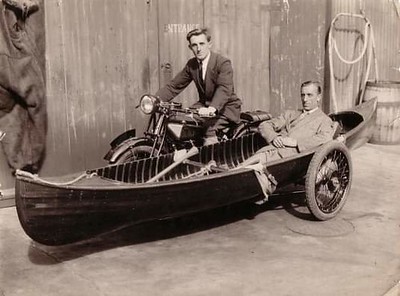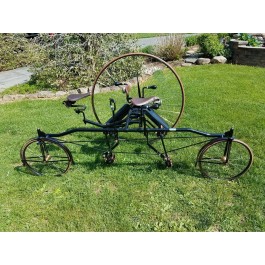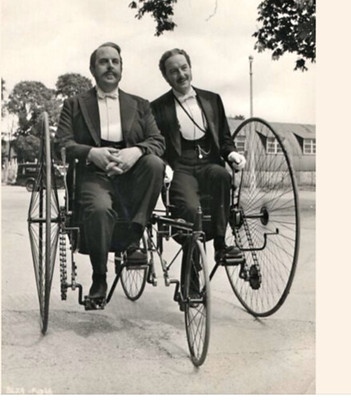|
|
Coventry Rotary Tandem TricycleDescription1886 Coventry Tandem - A high wheel tricycle made by Rudge Company of Coventry England. Also known as the Rudge Rotary. Built to get the ladies involved in cycling in the 1880s.Click here for a slideshow of other vehicles in the collection In 1894 the Rudge Cycle Co or Rudge Company would merge with Whitworth Cycle Co of Birmingham to form the Rudge Whitworth Cycles company. They would go on to make some very nice motorcycles. Below is a Rudge-Whitworth with reportedly a factory equipped canoe sidecar. We have not been able to verify that Rudge-Whitworth did offer this type sidecar.  Click here for more info on the Rudge Whitworth Cycles company This one is one of 5 built/rebuilt by famed bicycle collector/restorer Mel Short. Made with original parts as well as reproduced parts. M.S. built/rebuilt 2 without a serial numbers, a tandem and a single seat. He built 3 with serial numbers. He used an original 1886 single seat bike as a guide. The frame is made from DOM tubing and the wheel hubs were machined from solid bronze. Mel machined the hubs from solid bronze himself. The spokes are stainless steel. Although trikes aren't widely used by adults now, they certainly were in the 1880s. They were particularly popular with people who weren't comfortable balancing high atop the penny farthing bicycles of the time, along with women wearing long dresses, who couldn't easily straddle such bikes. The Coventry Rotary was designed by British cycling pioneer James Starley, and was manufactured in the UK city of Coventry starting in 1877. The original company was called "The Tangent and Coventry Tricycle Co Ltd" of Spon Street, Coventry. It featured two small inline wheels on the right-hand side, along with a single large wheel on the left. The rider was seated on a saddle mounted on a crossbar between them, where they pedalled a chain drive that delivered power to the big wheel. Instead of handlebars, there were two hand levers – one activated a brake on the drive wheel, while the other provided steering by pivoting the two rod-linked smaller wheels. It was able to ride relatively smoothly on traditional dual-wheel-rutted dirt roads, unlike normal tricycles, it didn't have a wheel in the middle that would ride up on the hump between the ruts. Additionally, cargo could be mounted on its long straight frame, making it popular with people such as photographers and fishermen. The company also made a side by side version. See pictures. Click here for pictures of the delivery version Click here for pictures of this bike being built/rebuilt Awards/Honors 2018 On Display at the Rural Heritage Museum in Maryland Top 5 Bicycle award and Peoples Choice award @ Simple Transport Show 2019 Featured in June 2019 Motorcycle Monthly Magazine Oldest British Bike Award at Classic Motorcycle Day 2021 Top Five Bike Award @ Simple Transport 14 This 1886 Coventry is pictured here with our 1986 Honda Gyro. These two bikes are 100 years a part. Here is a cool concept vehicle with a similar design as the Coventry:  At about the same time this bike was made in the late 1800s, many manufacturers were experimenting with different designs. One design was a chainless bicycle. Enjoy this video on the history of chainless bicycles. In many tandem bicycles of this period, the lady rode in front. Do you know why? Before the 1890s, the bicycle was a vastly different vehicle and was by no means popular. Between the 1860s and the mid-1880s, the standard bicycle was the ordinary or high wheeler, which was both hard to master and dangerous to use. While the ordinary was exclusively used by men, women were allowed to use bicycles such as the two-seater sociable, the tandem, and the tricycle. Beginning in the late 1860s companionate riding became a popular social activity for men and women. These vehicles allowed men and women to develop new methods of coed socialization. However, up until the mid 1880s, women were primarily dependent upon men in order to participate in cycling. The presence of a man in control of the sociable assumed that the man could keep the woman safe from the dangers of riding a bike alone, thereby assuming the authority of man. So while companionate riding was revolutionary in the development in sociability between men and woman, it kept women in an inferior position to men by assuming that the man had the power over the bicycle in that situation. Click here for more reading on Bicycling and feminism Here is another type of tandem bicycle of the period. A 1896 Olympia Tandem Tricycle.  Equipment Specifications
Detailed Information
|






















